This post may contain affiliate links, including those from Amazon Associates. If you make a purchase through these links, I may earn a commission at no additional cost to you. Learn more about our affiliate policy.
Some evenings the energy in your living room feels restless. The lights are too sharp, the surfaces too full, and your body keeps the pace of the day long after it ends.
Your shoulders stay tense. Your thoughts race. The space meant to soothe you feels like one more demand.
What you might need isn’t a renovation, but a reset.
For more guidance on creating sensory calm in shared spaces, see these easy ways to make your living room feel peaceful and relaxing.
Subtle, sensory shifts can help your home mirror the calm your nervous system craves.
This guide offers ten gentle edits that soften overstimulation and help your living room become a place where you can truly exhale.
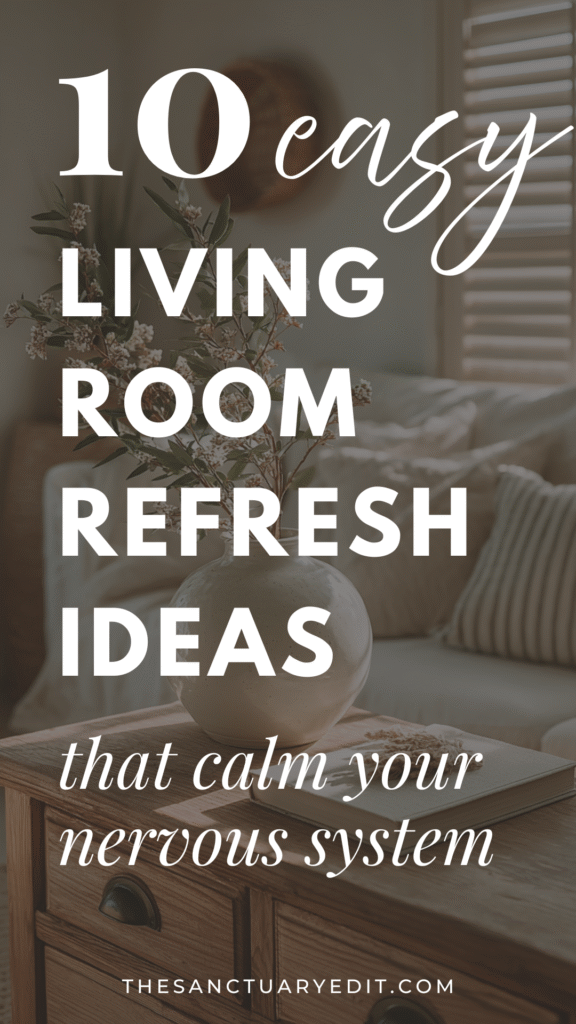
1. Layer soft, indirect lighting
Light shapes mood more than any other element in a room. When overhead bulbs are too bright or cool-toned, they activate the nervous system instead of relaxing it. The simplest way to bring calm back is to layer lighting rather than relying on a single source.
Add table and floor lamps with warm white bulbs, around 2700K or less. Use lampshades that diffuse light rather than cast harsh beams. If possible, choose dimmable bulbs or smart plugs so you can lower brightness in the evening. Wall sconces that gently wash light up or down a wall are especially regulating.
Try switching off the overhead light entirely at dusk and letting the room glow from corners instead. The visual softness tells your body it’s time to unwind.
2. Declutter visually before physically
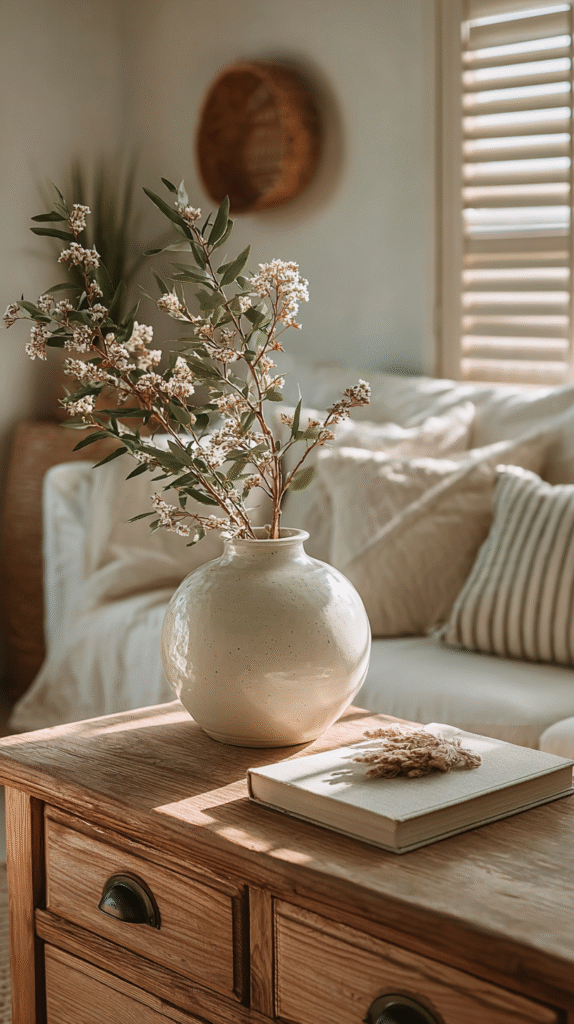
Your nervous system processes everything you see. When surfaces are crowded, your mind reads it as work left unfinished. Start your refresh not by deep cleaning, but by giving your eyes a moment of rest.
Look around and notice one surface that feels heavy. Clear it, then edit what returns. Keep only a few meaningful or beautiful objects—a candle, a branch in a vase, a book you’re reading. Place the rest in a small basket or drawer out of sight.
Visual quiet instantly slows your breathing. Even one clear surface can create a noticeable shift in how the room feels.
3. Re-orient furniture to support flow
Sometimes the way a room is arranged creates subtle tension. When pieces block natural movement or conversation, your body feels it as unease. Try pulling furniture slightly away from walls to create breathing space.
If possible, allow natural pathways so you can move with ease from one side to the other. Create a small “pause zone”, a chair by a window or a reading nook tucked out of the main flow. This small edit invites presence and calm without changing anything major.
You might notice that energy moves differently through the room once it’s rearranged. Less resistance. More openness.
4. Add grounding natural textures
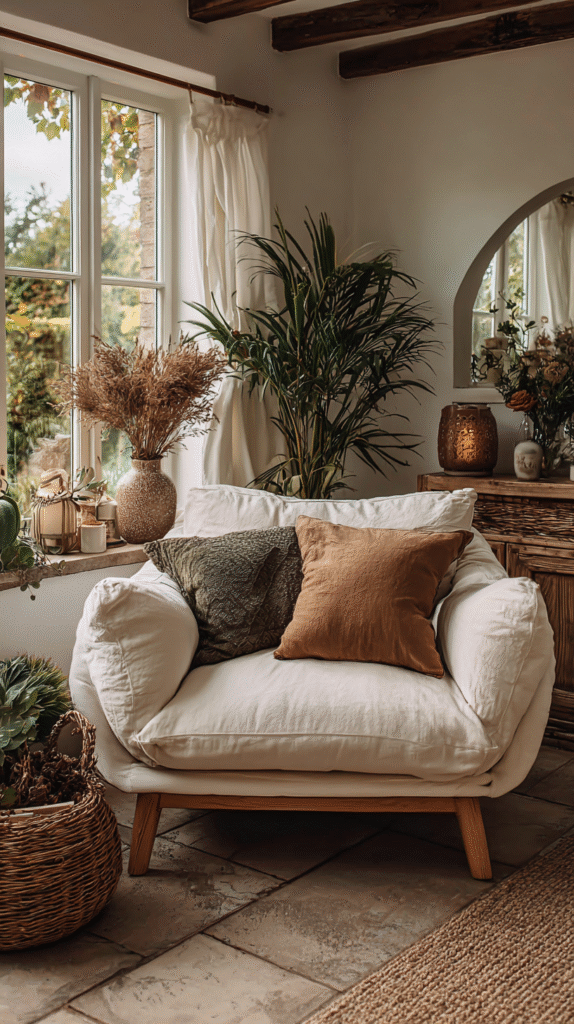
A nervous system sanctuary invites touch as much as sight. Synthetic fabrics and slick surfaces can feel overstimulating over time, while natural materials signal warmth and safety.
Layer soft, tactile pieces throughout the room. A linen throw draped over the sofa, a jute or wool rug underfoot, a wooden tray, a ceramic bowl. Each adds grounding texture and helps the space feel lived-in rather than styled.
Natural materials remind your senses of the outdoors. They create a connection point between the built environment and your body’s need for organic calm.
5. Bring in living energy with plants
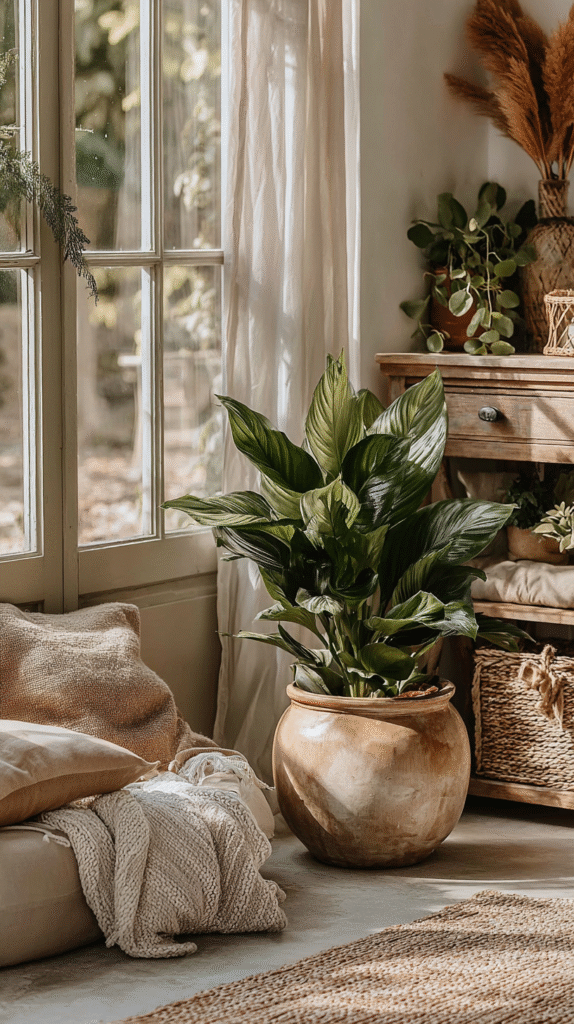
Plants change the energy of a room on both visual and emotional levels. Their quiet growth adds life and movement, while their green tones help regulate the nervous system.
Choose one or two easy plants like a pothos trailing from a shelf, a snake plant in a corner, or a vase with a single leafy branch. Resist overfilling the room. Let each have its own space to breathe.
Tending to a plant becomes a ritual of presence. A reminder that stillness and growth can happen together.
6. Reframe art and meaningful objects mindfully
Walls and surfaces often collect things over time, creating subtle noise. Editing them with intention helps a room feel settled.
Remove anything that doesn’t resonate with who you are now. Keep only what brings quiet joy or a sense of meaning. Try grouping a few items together like a small framed photograph, a stone and a handmade bowl, rather than scattering many objects across every surface.
When you curate your environment this way, your nervous system reads coherence and ease. Every item earns its place, contributing to a calm visual rhythm.
7. Refresh the air and introduce subtle scent
Stale air and overpowering fragrance both contribute to sensory fatigue. A calm living room should smell like nothing and something at the same time, fresh, light, clean, familiar.
Open windows for a few minutes each day, even in cooler months, to circulate oxygen and shift the energy of the space. Consider a natural diffuser with essential oils like cedarwood, lavender, or bergamot. Choose gentle scents rather than complex blends.
The goal isn’t to mask or perfume, but to create an invisible layer of calm that signals to your body that the space is safe.
8. Refresh your color palette
Color holds emotion. Certain hues stimulate, while others invite rest. You don’t need to repaint your entire room to feel the difference. Start small with textiles or accessories.
Add a throw pillow in sage, muted clay, or soft terracotta. Swap a bright print for one with earth tones. A simple tonal shift can harmonize a space. Neutral foundations like ivory, sand and oatmeal work beautifully when balanced with warm undertones.
Colors drawn from nature help your body feel anchored. They whisper rather than shout, allowing your mind to settle.
9. Layer cozy textiles
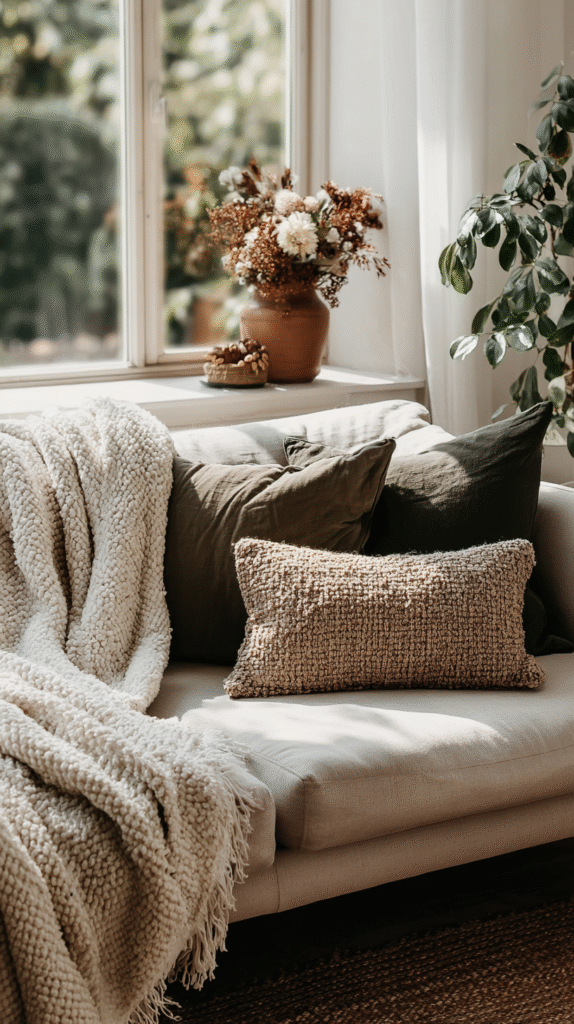
Texture is one of the fastest ways to shift a room’s mood. It adds warmth, comfort, and visual depth—all essential for nervous system calm.
Choose a few well-made pieces that invite touch: a linen or boucle throw, pillows with natural fill, a thick woven rug underfoot. Layer them in varied scales—fine-knit beside coarse weave, smooth linen beside wool.
When you sink into a sofa wrapped in tactile comfort, your body receives a signal of safety. Softness translates to care, and care translates to calm.
10. Create a simple evening reset ritual
The most transformative edit is not what you add, but what you do. Designate a small moment each evening to reset your living room and your mind.
Dim the lights. Fold a blanket. Light a candle or let a diffuser glow softly. Return stray objects to their place. These gestures tell your nervous system the day is complete.
You might even choose one corner, a console, a shelf, or a coffee table as a small altar of intention. A single vase, a stone, a book. Keep it consistent so your body learns that this space equals rest.
When you honor your living room as part of your regulation ritual, it becomes more than décor, it becomes medicine.
If you want to extend this ritual beyond décor and lighting, explore how to create a cozy Sunday night routine in your living room that gently closes the week and prepares your body for deeper rest.
Closing Reflection
Refreshing your living room doesn’t require new furniture or large expense. Each of these edits can be done in minutes, layered over time.
The key is noticing how each change feels. Does your body soften when you enter the room? Does the light feel gentler, the space more open, the air easier to breathe?
The goal isn’t perfection. It’s presence. A nervous system sanctuary begins when your home starts working with you, not against you.
You can also look at how to create a peaceful home that supports nervous system regulation if you’re ready to extend these principles throughout your entire home.
Let your living room become a place that teaches your body to slow down. One light dimmed, one surface cleared, one soft texture added at a time. Small edits, lasting calm.


